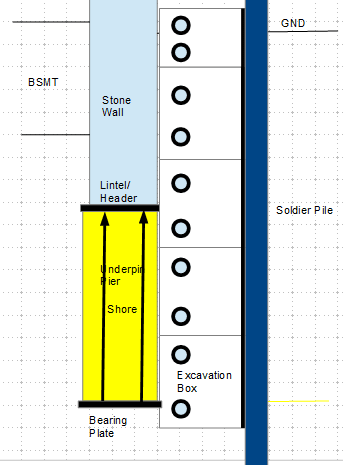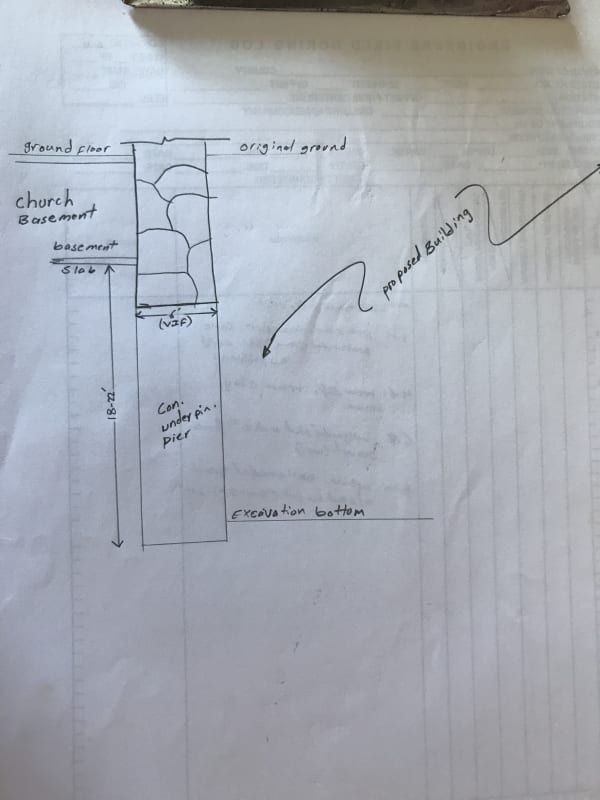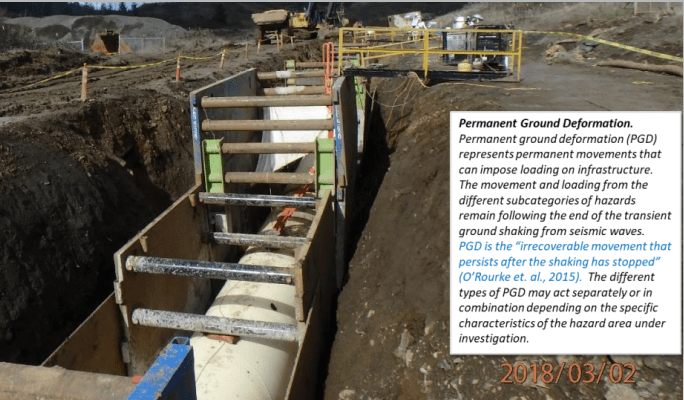Navigation
Install the app
How to install the app on iOS
Follow along with the video below to see how to install our site as a web app on your home screen.
Note: This feature may not be available in some browsers.
More options
Style variation
-
Congratulations TugboatEng on being selected by the Eng-Tips community for having the most helpful posts in the forums last week. Way to Go!
You are using an out of date browser. It may not display this or other websites correctly.
You should upgrade or use an alternative browser.
You should upgrade or use an alternative browser.
Underpinning 6 ft thick rubble wall 4
- Thread starter EngMan40
- Start date
- Status
- Not open for further replies.
Some Questions & Considerations:
[li]By "6 ft thick" do you mean 6 feet from front to back or the vertical height?[/li]
[li]Does the rubble stone wall have a concrete footing (probably not)?[/li]
[li]Is the stone securely mortared to hold the stones together?[/li]
[li]Will the width of the underpinning piers need to be reduced to maintain stability of the stone wall?[/li]
[li]Can or should the wall be underpinned halfway from each side?[/li]
[li]Will there be significantly better bearing at the bottom of the underpinning than at the bottom of the existing foundation?[/li]
[li]Is ground water going to be encountered while underpinning?[/li]
[li]What is the total height of unbalanced earth load on the wall? Check overturning and sliding. For thick walls and a heavy church, the might not be a problem.[/li]
[li]Underpinning pits should be hand dug and shored as the pit is being dug in lifts of about 4 vertical feet in order to protect the pit worker and the structure.[/li]
[li]This massive concrete underpinning should not need reinforcing steel or high strength, non-shrink concrete or dry pack.[/li]
[li]By "6 ft thick" do you mean 6 feet from front to back or the vertical height?[/li]
[li]Does the rubble stone wall have a concrete footing (probably not)?[/li]
[li]Is the stone securely mortared to hold the stones together?[/li]
[li]Will the width of the underpinning piers need to be reduced to maintain stability of the stone wall?[/li]
[li]Can or should the wall be underpinned halfway from each side?[/li]
[li]Will there be significantly better bearing at the bottom of the underpinning than at the bottom of the existing foundation?[/li]
[li]Is ground water going to be encountered while underpinning?[/li]
[li]What is the total height of unbalanced earth load on the wall? Check overturning and sliding. For thick walls and a heavy church, the might not be a problem.[/li]
[li]Underpinning pits should be hand dug and shored as the pit is being dug in lifts of about 4 vertical feet in order to protect the pit worker and the structure.[/li]
[li]This massive concrete underpinning should not need reinforcing steel or high strength, non-shrink concrete or dry pack.[/li]
Reminds me of a stone wall surrounding a prison. Had been built by prisoners. Thus it has a lot of voids. Required injecting grout to fill all the voids. Then, since it was supporting a high stone wall, then tilted and somewhat uneven settled, required compaction grout injected below to raise it and straighten it. In the case of church it may require the same treatment. I'd suspect no new footing needed.
- Thread starter
- #4
By "6 ft thick" do you mean 6 feet from front to back or the vertical height? [6 ft front to back - to be confirmed with horizontal cores]
Does the rubble stone wall have a concrete footing (probably not)? Most likely not [church built in 1899]
Is the stone securely mortared to hold the stones together? [looks decent above ground, no information about its basement from outside, still have to visit the basement on inside to probably core to confirm exact thickness].
Will the width of the underpinning piers need to be reduced to maintain stability of the stone wall? [I was thinking of pushing a steel plate all the way below the wall for each pier and keep it and drypack below it].
Can or should the wall be underpinned halfway from each side? [I don't know if contractor will mobilize inside church basement]
Will there be significantly better bearing at the bottom of the underpinning than at the bottom of the existing foundation? [ yes bearing is not an issue, very dense natural material]
Is ground water going to be encountered while underpinning? [groundwater is couple feet below bottom of pit]
What is the total height of unbalanced earth load on the wall? Check overturning and sliding. For thick walls and a heavy church, the might not be a problem. [I am hoping to confirm such thick foundation to eliminate tiebacks, the soil height is 18 to 22 ft below the basement] all soil below the basement is dense to very dense natural soil].
Underpinning pits should be hand dug and shored as the pit is being dug in lifts of about 4 vertical feet in order to protect the pit worker and the structure. [that is why I want to put a steel plate]
This massive concrete underpinning should not need reinforcing steel or high strength, non-shrink concrete or dry pack. [ why not put drypack any specific reason].
Does the rubble stone wall have a concrete footing (probably not)? Most likely not [church built in 1899]
Is the stone securely mortared to hold the stones together? [looks decent above ground, no information about its basement from outside, still have to visit the basement on inside to probably core to confirm exact thickness].
Will the width of the underpinning piers need to be reduced to maintain stability of the stone wall? [I was thinking of pushing a steel plate all the way below the wall for each pier and keep it and drypack below it].
Can or should the wall be underpinned halfway from each side? [I don't know if contractor will mobilize inside church basement]
Will there be significantly better bearing at the bottom of the underpinning than at the bottom of the existing foundation? [ yes bearing is not an issue, very dense natural material]
Is ground water going to be encountered while underpinning? [groundwater is couple feet below bottom of pit]
What is the total height of unbalanced earth load on the wall? Check overturning and sliding. For thick walls and a heavy church, the might not be a problem. [I am hoping to confirm such thick foundation to eliminate tiebacks, the soil height is 18 to 22 ft below the basement] all soil below the basement is dense to very dense natural soil].
Underpinning pits should be hand dug and shored as the pit is being dug in lifts of about 4 vertical feet in order to protect the pit worker and the structure. [that is why I want to put a steel plate]
This massive concrete underpinning should not need reinforcing steel or high strength, non-shrink concrete or dry pack. [ why not put drypack any specific reason].
What is the total height of unbalanced earth load on the wall? Check overturning and sliding. For thick walls and a heavy church, the might not be a problem. [I am hoping to confirm such thick foundation to eliminate tiebacks, the soil height is 18 to 22 ft below the basement] all soil below the basement is dense to very dense natural soil].
That is not what I meant. Are you excavating in front of the underpinned wall? If so, what will be the height of the retained soil from the basement elevation to the excavation subgrade in front of the underpinning? If you are excavating in front, you need this height to check for overturning and sliding of both the stone wall and the underpinning piers.
Underpinning pits should be hand dug and shored as the pit is being dug in lifts of about 4 vertical feet in order to protect the pit worker and the structure. [that is why I want to put a steel plate]
I would not even try to install a steel plate on top of the underpinning. It's not needed and would be difficult and costly to install and to make sure it has full bearing on the underpinning. Don't do it. he compressive stress in the underpinning will be much less than 100 psi. No plate needed.
This massive concrete underpinning should not need reinforcing steel or high strength, non-shrink concrete or dry pack. [ why not put drypack any specific reason].
Of course you need dry pack - just not high strength, or non-metallic, or non-shrink.
That is not what I meant. Are you excavating in front of the underpinned wall? If so, what will be the height of the retained soil from the basement elevation to the excavation subgrade in front of the underpinning? If you are excavating in front, you need this height to check for overturning and sliding of both the stone wall and the underpinning piers.
Underpinning pits should be hand dug and shored as the pit is being dug in lifts of about 4 vertical feet in order to protect the pit worker and the structure. [that is why I want to put a steel plate]
I would not even try to install a steel plate on top of the underpinning. It's not needed and would be difficult and costly to install and to make sure it has full bearing on the underpinning. Don't do it. he compressive stress in the underpinning will be much less than 100 psi. No plate needed.
This massive concrete underpinning should not need reinforcing steel or high strength, non-shrink concrete or dry pack. [ why not put drypack any specific reason].
Of course you need dry pack - just not high strength, or non-metallic, or non-shrink.
- Thread starter
- #6
That is not what I meant. Are you excavating in front of the underpinned wall? If so, what will be the height of the retained soil from the basement elevation to the excavation subgrade in front of the underpinning? If you are excavating in front, you need this height to check for overturning and sliding of both the stone wall and the underpinning piers.
The 18 to 22 ft is the amount of soil to be excavated in front of the pier (height of retained soil). so the underpinning is shoring too.
I would not even try to install a steel plate on top of the underpinning. It's not needed and would be difficult and costly to install and to make sure it has full bearing on the underpinning. Don't do it. he compressive stress in the underpinning will be much less than 100 psi. No plate needed.
I am thinking the plate will be pushed in before excavation starts. the plate will be in contact with the wall since it is pushed in before excavation starts. I can oversize the plate length and width to be pushed beyond the limits of excavation. The excavation bracing will ensure the plate is kept in place. I am concerned that for a thick wall, there will be loose pieces or rubble dislodged from the bottom of the wall and full into the underpinning pier so the plate will be a safety measure. The dry pack will be installed between the steel plate and the concrete underpinning pier.
The 18 to 22 ft is the amount of soil to be excavated in front of the pier (height of retained soil). so the underpinning is shoring too.
I would not even try to install a steel plate on top of the underpinning. It's not needed and would be difficult and costly to install and to make sure it has full bearing on the underpinning. Don't do it. he compressive stress in the underpinning will be much less than 100 psi. No plate needed.
I am thinking the plate will be pushed in before excavation starts. the plate will be in contact with the wall since it is pushed in before excavation starts. I can oversize the plate length and width to be pushed beyond the limits of excavation. The excavation bracing will ensure the plate is kept in place. I am concerned that for a thick wall, there will be loose pieces or rubble dislodged from the bottom of the wall and full into the underpinning pier so the plate will be a safety measure. The dry pack will be installed between the steel plate and the concrete underpinning pier.
- Thread starter
- #8
- Thread starter
- #10
Check your local laws. I my area when you dig alongside a building that owner takes care of protecting his foundation for an excavation 10 ft. Below that ALL work is at the cost of the excavator. Thus it looks like the nearby guy would have to protect the existing church and not necessarily have to underpin.
Just a quick thinking - I think the church wall above ground may need support throughout the excavation. Are you intended to install piling inside of the basement, a few inches away from the stone wall/underpinning pier? A stiff plate under the stone wall is a good idea, it acts as lintel while excavate beneath it.
-
2
- #15
This type of job requires a contractor with experience in similar conditions. He won't need advice from those that never did this thing before. Might not get that here. EngMann in reading responses, check the background info in the poster's heading. Enuff said.
- Thread starter
- #16
@PEinc: from your experience what do you see as bad idea in the plate being inserted just below the existing church wall before underpinning pit is excavated? and what safety measure do you suggest as a designer to protect workers in the pit?
EngMann, what makes you think that you will get the plate pushed in tight against a rubble stone footing/foundation wall that probably has an uneven bottom? What makes you think that forcing the plate in under the stone footing will not dislodge some stones? With this plate in place, how will you be able to dry pack the top of the underpinning pier and properly transfer the building load to the pier? I have designed and built a couple hundred underpinning jobs, most with rubble stone footings. Only a few were 6' wide. If the stones are mortared OK, then you should be able to get your approach pit started and then, if necessary, place a temporary wood shelf/shield just under the bottom of the wall until you have excavated and shored the pit and have placed the concrete. Then the wood shelf gets removed and you dry pack the remaining space between the top of the underpinning pier and the bottom of the stone wall. If the stones are loose, the design does not change but you need a very experienced underpinning contractor. The problem is that too many contractors think they are underpinning experts. Most are not and do underpinning dangerously wrong. Underpinning pits should be hand excavated and shored in lifts as the pit excavation progresses. If you do not understand what I am saying or think this is too slow and expensive, you should not be doing the design. Also, YouTube is full of bad videos showing improper underpinning techniques from unqualified contractors. Please review on my web site the presentation titled Philadelphia’s Recent Building Collapses – Causes and Prevention.
if necessary, place a temporary wood shelf/shield just under the bottom of the wall until you have excavated and shored the pit and have placed the concrete.
Wood board can work with adequate stiffness to prevent excessive settlement/deflection of the wall. Either it is wood or steel plate, it can be removed after the underpin pier reached its elevation, but not in touch with it. Grout, or dry pact, can be used to fill the gap.
A thinking for excavation for comment.

- Thread starter
- #20
PEinc: For this high profile job, there is no room for inexperienced underpinning contractors. The plate will be permanent and I am drypacking below it. I can push the soil few inches below the bottom of the wall to avoid hitting the rubble wall stones and dislodging them. I would think that few inches of soil will not cause settlement of the wall if left as long as plate is in contact with the bottom of the wall and the drypacking is properly placed between the top of the concrete pier and bottom of the plate. The wood shelf also works to protect the workers in the pit but it will be installed after excavating the underpinning pit where there is a possibility of some pieces from the bottom of the wall falling down which is what I am trying to avoid by installing the plate before excavation takes place. Can you share some photos from the few jobs you designed involving the thick stone wall?
- Status
- Not open for further replies.
Similar threads
- Locked
- Question
- Replies
- 6
- Views
- 5K
- Replies
- 33
- Views
- 2K
- Locked
- Question
- Replies
- 5
- Views
- 4K
- Replies
- 5
- Views
- 453
- Replies
- 2
- Views
- 541


